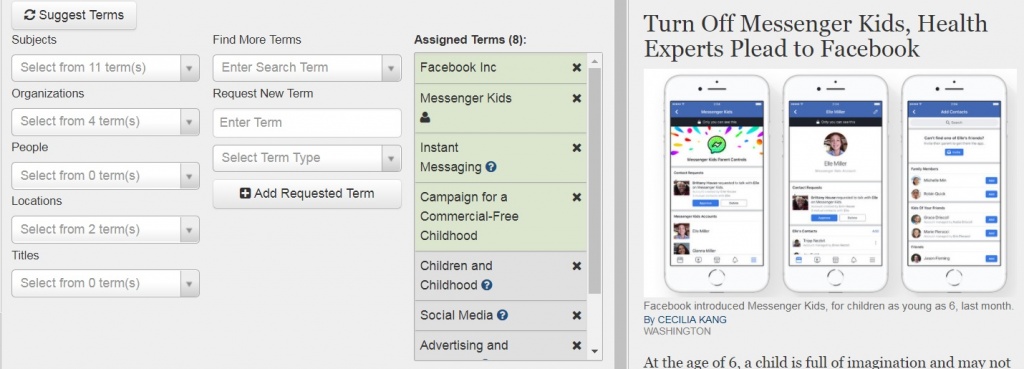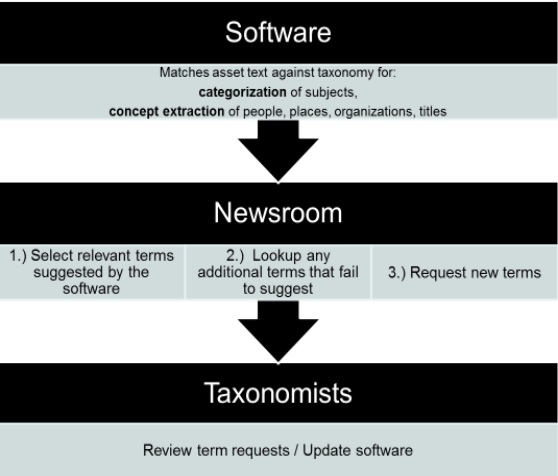Categories
Archives

By Jennifer Parrucci
Senior Taxonomist at The New York Times
Lead of IPTC’s NewsCodes Working Group
The New York Times has a proud history of metadata. Every article published since The Times’s inception in 1851 contains descriptive metadata. The Times continues this tradition by incorporating metadata assignment into our publishing process today so that we can tag content in real-time and deliver key services to our readers and internal business clients.
I shared an overview of The Times’s tagging process at a recent conference held by the International Press Telecommunications Council in Barcelona. One of the purposes of IPTC’s face-to-face meetings is for members and prospective members to gain insight on how other member organizations categorize content, as well as handle new challenges as they relate to metadata in the news industry.
Why does The New York Times tag content today?
The Times doesn’t just tag content just for tradition’s sake. Tags play an important role in today’s newsroom. Tags are used to create collections of content and send out alerts on specific topics. In addition, tags help boost relevance on our site search and send a signal to external search engines, as well as inform content recommendations for readers. Tags are also used for tracking newsroom coverage, archive discovery, advertising and syndication.
How does The New York Times tag content?
The Times employs rules-based categorization, rather than purely statistical tagging or hand tagging, to assign metadata to all published content, including articles, videos, slideshows and interactive features.
Rules-based classification involves the use of software that parses customized rules that look at text and suggest tags based on how well they match the conditions of those rules. These rules might take into account things like the frequency of words or phrases in an asset, the position of words or phrases, for example whether a phrase appears in the headline or lead paragraph, a combination of words appearing in the same sentence, or a minimum amount of names or phrases associated with a subject appearing in an asset.
Unlike many other publications that use rules-based classification, The Times adds a layer of human supervision to tagging. While the software suggests the relevant subject terms and entities, the metadata is not assigned to the article until someone in the newsroom selects and assigns tags from that list of suggestions to an asset.
Why does The Times use rules-based and human supervised tagging?
This method of tagging allows for more transparency in rule writing to see why a rule has or has not matched. Additionally it gives the ability to customize rules based on patterns specific to our publication. For example, The Times has a specific style for obituaries, whereby the first sentence usually states someone died, followed by a short sentence stating his or her age. This language pattern can be included in the rule to increase the likelihood of obituaries matching with the term “Deaths (Obituaries).” Rules-based classification also allows for the creation of tags without needing to train a system. This option allows taxonomists to create rules for low-frequency topics and breaking news, for which sufficient content to train the system is lacking.
These rules can then be updated and modified as a topic or story changes and develops. Additionally, giving the newsroom rule suggestions and a controlled vocabulary to choose from ensures a greater consistency in tagging, while the human supervision of the tagging ensures quality.
What does the tagging process at The New York Times look like?
Once an asset (an article, slideshow, video or interactive feature) is created in the content management system, the categorization software is called. This software runs the text against the rules for subjects and then through the rules for entities (proper nouns). Once this process is complete, editors are presented with suggestions for each term type within our schema: subjects, organizations, people, locations and titles of creative works. The subject suggestions also contain a relevancy score. The editor can then choose tags from these suggestions to be assigned to an article. If they do not see a tag that they know is in the vocabulary suggested to them, the editors have the option to search for that term within the vocabulary. If there are new entities in the news, the editors can request that they be added as new terms. Once the article is published/republished the tags chosen from the vocabulary are assigned to the article and the requested terms are sent to the Taxonomy Team.
The Taxonomy Team receives all of the tag requests from the newsroom in a daily report. Taxonomists review the suggestions and decide whether they should be added to the vocabulary, taking into account factors such as: news value, frequency of occurrence, and uniqueness of the term. If the verdict is yes, then the taxonomist creates a new entry for the tag in our internal taxonomy management tool and disambiguates the entry using Boolean rules. For example, there cannot be two entries both named “Adams, John” for the composer and the former United States president of the same name. To solve this, disambiguation rules are added so that the software knows which one to suggest based on context.
John Adams,_IF:{(OR,”composer”,”Nixon in China”,”opera”…)}::Adams, John (1947- )
John Adams,_IF:{(OR,”federalist”,”Hamilton”,”David McCullough”…)}:Adams, John (1735-1826)
Once all of these new terms are added into the system, the Taxonomy Team retags all assets with the new terms.
In addition to these term updates, taxonomists also review a selection of assets from the day for tagging quality. Taxonomists read the articles to identify whether the asset has all the necessary tags or has been over-tagged. The general rule is to tag the focus of the article and not everything mentioned. This method ensures that the tagging really gets to the heart of what the piece is about. When doing this review, taxonomists will notice subject terms that are either not suggesting or suggesting improperly. The taxonomist uses this opportunity to tweak the rules for that subject so that the software suggests the tag properly next time.
After this review of the tagging process at the New York Times, the Taxonomy Team compiles a daily report back to the newsroom that includes shoutouts for good tagging examples, tips for future tagging and a list of all the new term updates for that day. This email keeps the newsroom and the Taxonomy Team in contact and acts as a continuous training tool for the newsroom.
All of these procedures come together to ensure that The Times has a high quality of metadata upon which to deliver highly relevant, targeted content to readers.
Read more about taxomony and IPTC standard Media Topics.
